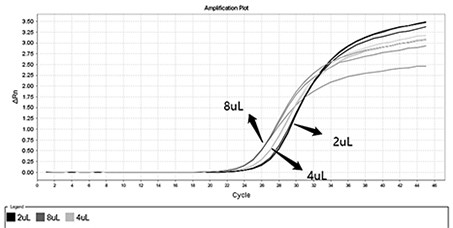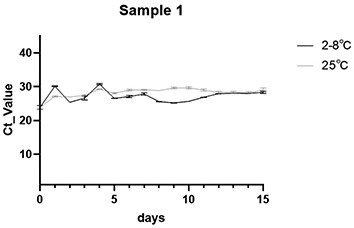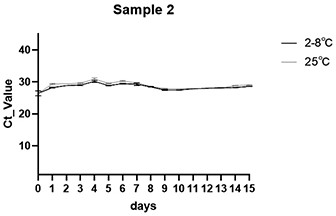Biological sample nucleic acid release preservative
A nucleic acid release and biological sample technology, applied in the field of molecular biology, can solve the problems of long-term preservation of nucleic acid, cumbersome operation, and inability to directly amplify
- Summary
- Abstract
- Description
- Claims
- Application Information
AI Technical Summary
Problems solved by technology
Method used
Image
Examples
Embodiment 1
[0030] Example 1: Nucleic acid detection of β-actin in human buccal swabs.
[0031] 1. The detection method includes the following steps.
[0032] step one.
[0033] Take a person's oral swab, put the swab directly into 1ml of the sample release agent, turn it upside down several times, and discard the swab after the color of the reagent changes from grape purple to orange-green to obtain a mixed solution.
[0034] step two.
[0035] Take 2 μl, 4 μl and 8 μl of processed samples to configure the qPCR system, and do three parallel experiments for each volume of samples. The fam channel detects human β-actin mRNA. The primer design (human β-actin mRNA detection primers and probes Needle: HB-FCGAGCACAGAGCCTCGC; HB-R CATCATCCATGGTGAGCTGG; HB-P FAM-ATCCGCCGCCCGTCCA-MGB) are spanning intronic primers, which can only specifically amplify human β-actin mRNA, but cannot amplify its coding DNA.
[0036] Second, PCR amplification.
[0037] The detection equipment is ABI 7500, and the r...
Embodiment 2
[0040] Example 2: Human oral swabs The test results of the storage of nucleic acids released from human oral swabs at room temperature (25°C) and in refrigerators (2°C-8°C).
[0041] step one.
[0042] Take oral swabs (sample A, sample B, sample C) of three different people, put the swabs of different samples directly into different 1ml release agents of this sample, turn them upside down several times until the color of the reagent changes from grape purple Discard the swab after it turns orange-green to obtain a mixed solution. Divide each sample into two equal parts, one at room temperature (25°C), and the other in a refrigerator at 2-8°C.
[0043] step two.
[0044] Perform PCR detection on the first day, the second day, the third day until the 15th day according to step 2 of Example 1 and the PCR amplification method.
[0045] 3. Experimental results.
[0046] See Figure 2, Figure 3, Figure 4 , it can be seen that there is not much difference between the preservation...
PUM
 Login to View More
Login to View More Abstract
Description
Claims
Application Information
 Login to View More
Login to View More - R&D
- Intellectual Property
- Life Sciences
- Materials
- Tech Scout
- Unparalleled Data Quality
- Higher Quality Content
- 60% Fewer Hallucinations
Browse by: Latest US Patents, China's latest patents, Technical Efficacy Thesaurus, Application Domain, Technology Topic, Popular Technical Reports.
© 2025 PatSnap. All rights reserved.Legal|Privacy policy|Modern Slavery Act Transparency Statement|Sitemap|About US| Contact US: help@patsnap.com



